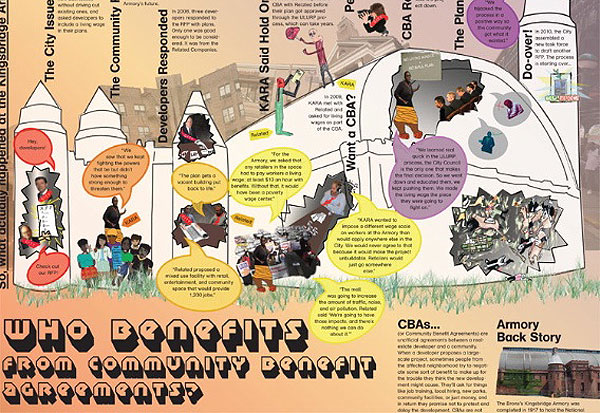
Photo by: Urban Investigators
This is a subsection of the 24” x 36” poster summarizing the students’ perspective on CBAs and the politics of the Kingsbridge Armory project.
About four years ago, the city put out a request for proposals for the redevelopment of the Kingsbridge Armory, a former National Guard ammunitions warehouse that has been vacant since 1994. Of the three proposals that were submitted by developers in 2008, one was taken into serious consideration and it spawned extensive analysis, debate and vehement opposition. Last week, fifteen Bronx high school students added their voices to the volatile mix.
The students spent their summer researching community benefit agreements and last Tuesday — in a dining hall at Hostos Community College — 10 of them presented their findings to an audience of about 80 people, including community leaders, teachers, family members, and peers. Also present were stakeholders in the Kingsbridge Armory redevelopment project.
The students did not unearth new information about the redevelopment project, but took sides on one of the most divisive issues – living wages. They said they agreed that the redevelopment should require prospective retailers to pay every worker a living wage of at least $10 per hour.
The students took turns explaining how they conducted their research and what they learned, and presented their final product: a 24” x 36” poster they created (with the help of artists Hatuey Ramos-Fermin and Prudence Katze) complete with diagrams, illustrations, and talking heads to summarize their perspective on CBAs and the politics of the Kingsbridge Armory project.
During the panel discussion that followed the student’s presentation, stakeholders talked about the armory. No new areas of consensus emerged among them about the project, but the event gave them an opportunity to get input from Bronx youth about the Kingsbridge Armory redevelopment. One of the panelists who participated in the discussion — Desiree Hunter, a community activist who belongs to the Kingsbridge Armory Redevelopment Alliance (KARA) and the Kingsbridge Armory Task Force — said that she plans to show the students’ poster to the task force.
“I think it’s wonderful to see young people grapple with complex issues,” said Bettina Damiani of Good Jobs New York, one of the other panelists at the presentation, “and come out with a knowledge of how a democratic process should work.”
The city’s 2006 request for Kingsbridge Armory redevelopment proposals led to a high-profile protracted community development battle. The proposal that the city selected was submitted by Related Companies and aimed to convert the castle-like 575,000 square foot building into retail, entertainment, and community space. When KARA, a coalition of Bronx community groups, asked Related Companies to agree to require all prospective retailers to pay their workers a living wage of $10 or more plus benefits, the company said no. Because Related and Bronx community organizations could not reach an agreement about the redevelopment, the city council voted the company’s proposal down in 2009, and the development process was sent back to the drawing board. In March of this year, Bronx Borough President Ruben Diaz, Jr. created a new task force to help move the Armory redevelopment forward.
The students presenting their views of the Kingsbridge Armory redevelopment were ten of the fifteen who participated in the most recent installment of a program called Urban Investigations, a series of projects coordinated by The Center for Urban Pedagogy. In each Urban Investigation, high school students are charged with collaboratively investigating one facet of how the city works. In the past, Urban Investigations have researched what happens to garbage after it’s thrown away, who owns the internet, and where public housing comes from. The question underlying the Kingsbridge Armory research was ‘Who benefits from CBAs?’
To create their poster, the Urban Investigators conducted interviews with decision makers and stakeholders involved in the Kingsbridge Armory project, including Desiree Hunter of KARA; Jesse Masyr, the lawyer for Related Companies; David Lombino of the Economic Development Corporation; Tom Angotti from the Comptroller’s Task Force on CBAs; and Vicki Been, a co-author of a report on CBAs. The students also went on site visits to the Kingsbridge Armory and conducted street interviews with members of the communities that will be most affected by any development that happens there.
The project gave some of the students an opportunity to learn about the city in a way that regular classroom learning does not. “I learned about CBAs,” said Luis Peña, a fifteen-year-old from the Urban Assembly for Applied Math and Science, whose mother told him to either do something constructive with his time over the summer or be sent back to the Dominican Republic, where their family is from. He chose the Urban Investigation. Before July, “I didn’t know [CBAs] existed at all,” he said.
“It’s hard to really construct a city,” said Taylor Feliciano, 17, a student at the Eagle Academy for Young Men and another Urban Investigation participant, as he reflected on what he learned over the course of the summer. “[Development] has to be settled with the community.”
The goal, according to project leader Valeria Mogilevich, was for students to not only learn about the complex development process that CBAs are a part of, but also to create a poster, a tangible final product, that would educate the public about the significance of CBAs in the Kingsbridge Armory redevelopment. She hopes the students will play a role in city-wide debate and have an impact on decision making.
“We’re trying to get students to change their perception of how the city works, and their potential impact on it,” said Mogilevich.








